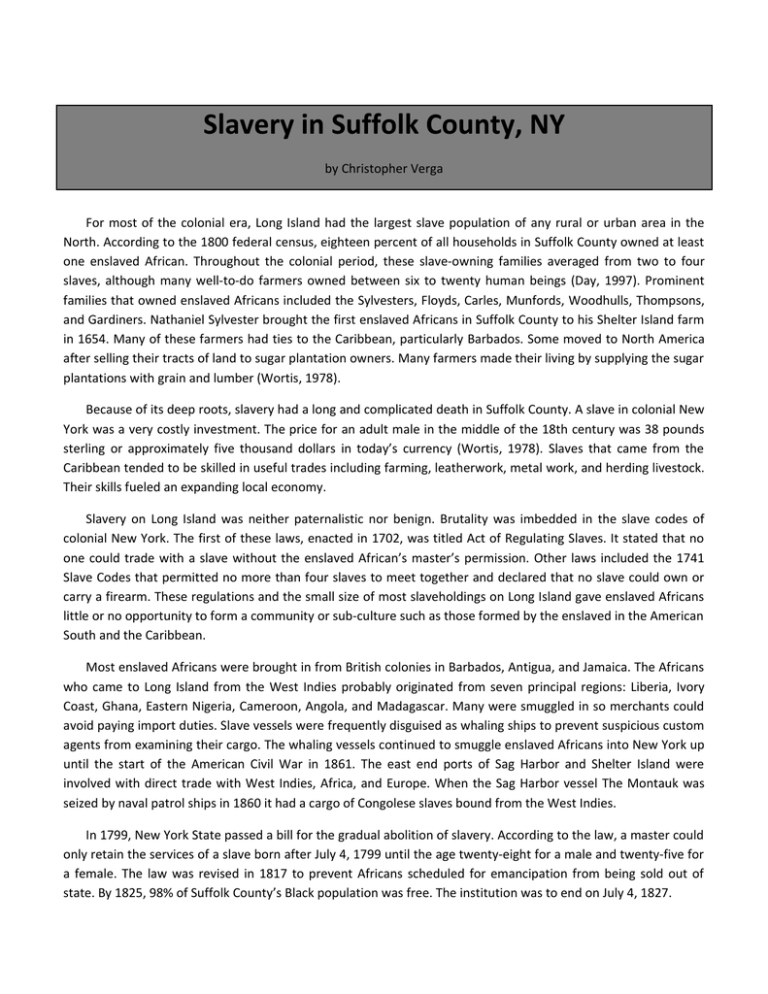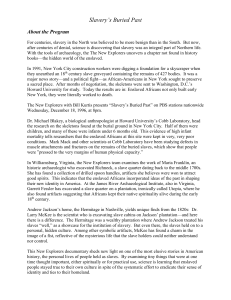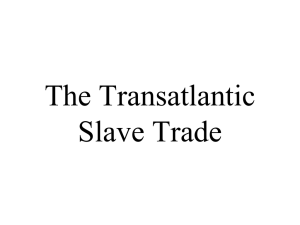Slavery in Suffolk County, NY
advertisement

Slavery in Suffolk County, NY by Christopher Verga For most of the colonial era, Long Island had the largest slave population of any rural or urban area in the North. According to the 1800 federal census, eighteen percent of all households in Suffolk County owned at least one enslaved African. Throughout the colonial period, these slave-owning families averaged from two to four slaves, although many well-to-do farmers owned between six to twenty human beings (Day, 1997). Prominent families that owned enslaved Africans included the Sylvesters, Floyds, Carles, Munfords, Woodhulls, Thompsons, and Gardiners. Nathaniel Sylvester brought the first enslaved Africans in Suffolk County to his Shelter Island farm in 1654. Many of these farmers had ties to the Caribbean, particularly Barbados. Some moved to North America after selling their tracts of land to sugar plantation owners. Many farmers made their living by supplying the sugar plantations with grain and lumber (Wortis, 1978). Because of its deep roots, slavery had a long and complicated death in Suffolk County. A slave in colonial New York was a very costly investment. The price for an adult male in the middle of the 18th century was 38 pounds sterling or approximately five thousand dollars in today’s currency (Wortis, 1978). Slaves that came from the Caribbean tended to be skilled in useful trades including farming, leatherwork, metal work, and herding livestock. Their skills fueled an expanding local economy. Slavery on Long Island was neither paternalistic nor benign. Brutality was imbedded in the slave codes of colonial New York. The first of these laws, enacted in 1702, was titled Act of Regulating Slaves. It stated that no one could trade with a slave without the enslaved African’s master’s permission. Other laws included the 1741 Slave Codes that permitted no more than four slaves to meet together and declared that no slave could own or carry a firearm. These regulations and the small size of most slaveholdings on Long Island gave enslaved Africans little or no opportunity to form a community or sub-culture such as those formed by the enslaved in the American South and the Caribbean. Most enslaved Africans were brought in from British colonies in Barbados, Antigua, and Jamaica. The Africans who came to Long Island from the West Indies probably originated from seven principal regions: Liberia, Ivory Coast, Ghana, Eastern Nigeria, Cameroon, Angola, and Madagascar. Many were smuggled in so merchants could avoid paying import duties. Slave vessels were frequently disguised as whaling ships to prevent suspicious custom agents from examining their cargo. The whaling vessels continued to smuggle enslaved Africans into New York up until the start of the American Civil War in 1861. The east end ports of Sag Harbor and Shelter Island were involved with direct trade with West Indies, Africa, and Europe. When the Sag Harbor vessel The Montauk was seized by naval patrol ships in 1860 it had a cargo of Congolese slaves bound from the West Indies. In 1799, New York State passed a bill for the gradual abolition of slavery. According to the law, a master could only retain the services of a slave born after July 4, 1799 until the age twenty-eight for a male and twenty-five for a female. The law was revised in 1817 to prevent Africans scheduled for emancipation from being sold out of state. By 1825, 98% of Suffolk County’s Black population was free. The institution was to end on July 4, 1827. A typical slave holding family in Suffolk County was the Gardiner-Thompson clan, two families bound together by multiple marriages. In 1758 Jonathan Thompson bought Apple Tree Neck (Sagtikos Manor) from Mary Carll, the widow of Captain Ansnisas Carll, for a little over 1,200 pounds. In 1772 his son Isaac married Mary Gardiner, the first of three marriages between members of these families. Mary Gardiner was the daughter of wealthy East Hampton resident Abraham Gardiner. When the Gardiner family first came to the America they worked with Massachusetts governor John Winthrop building forts and organizing to combat hostile Indians. In 1639 the Gardiner family acquired the 3,300 acres Gardiner Island, the first of several large local land patents. Sagtikos Manor, the historical home to this family, is mostly known as the house George Washington slept in during his American Revolutionary War victory tour, but this manor was home to several enslaved people who were erased from the history of Long Island. According to New York state census records the third proprietor of the Manor, Isaac Thompson, owned an average of four slaves in the decades of 1790, 1800, and 1810. Thompson held the local governmental position of overseer of the poor for Islip Township. The majority of the poor were former slaves that were released by their masters either because they were too old or too young to work. They became wards of the township and were deeded over as slaves or apprentices until they were able to provide for themselves. In most towns in Suffolk freed slaves were not allowed to own land and in most cases they rented property from their former masters, paying their rent in labor. Isaac Thompson’s 1,200 acre manor was the family’s primary source of income. Without slave labor, Isaac would not have been able to balance his local political career and the day-to-day maintenance of the farm. The manor produced dairy and agricultural products. Female slaves did kitchen work and prepared dairy products. Male slaves did field work and daily manor maintenance. Records show that in 1805, Isaac Thompson received three released slaves, Jemiah, Colinic, and Charity through the office of the overseer of the poor. They were listed as property in his last will and testament when he died in 1817. Thompson also owned Henry, who was deeded over him as a servant until the age of twenty-one in 1794 and Benjamin, whom he secured because of a debt owed him by Richard Udall. According to a journal kept by Dr. Samuel Thompson, Isaac Thompson leased at least five additional slaves from his brother to work on the manor. It was unclear whether Thompson’s sons inherited the enslaved Africans or if they were freed when Isaac Thompson died. Much of the historical detail of what we know about slavery in Suffolk County comes from the memoir of Venture Smith (1796), an enslaved African who was brought to the South Fork as a child. In his memoir, Smith described the work he did as a young boy depending on the season. It included carding wool, household business, and pounding four bushels of ears of corn every night in a barrel for the poultry. If he did not complete these tasks in a satisfactory manner he was “rigorously punished.” References Day, L. (1997). Making a Way to Freedom: A History of African Americans on Long Island. NY: Interlaken. Smith, V. (1796). Narrative of the Life and Adventures of Venture Smith, http://docsouth.unc.edu/neh/ venture2/menu.html, accessed October 10, 2010. Wortis, H. (1978). A Woman Named Matilda and Other True Accounts of Old Shelter Island. Shelter Island, NY: Shelter Island Historical Society. The Jay Heritage Center Although John Jay and various members of the Jay family were slave owners, he and his sons were leaders in the fight to abolish slavery and led by example in freeing their own slaves. John Jay was a founder of the New York Manumission Society in 1785 and served as its first president, as did his son, Peter Augustus Jay. Both men encountered great resistance to their efforts to extend civil rights to African Americans. As a delegate to the NY Constitutional Convention in 1821, Peter Augustus Jay argued to extend the right to vote to free African Americans. Despite his impassioned plea, these rights were not granted at this time. The names of several slaves owned by the Jays at their home in Rye are known, and some of their manumission papers have been located. Their stories, along with the Jay family’s involvement in slavery and its abolition, make the Jay Heritage Center an ideal location for consideration of these issues. The Jay Property is one of 13 sites on Westchester County's African American Heritage Trail. Designated a National Historic Landmark in 1993, it is a place where slaves are known to have lived and worked and where they were also emancipated by the Jay family. For more information and to schedule school trips contact: The Jay Heritage Center, 210 Boston Post Road, Rye, NY 10580 Phone (914) 698-9275 FAX (914) 835-8547 E-mail: JAYHC@earthlink.net http://www.jaycenter.org




